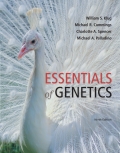
Concept explainers
Although it is customary to consider transcriptional regulation in eukaryotes as resulting from the positive or negative influence of different factors binding to DNA, a more complex picture is emerging. For instance, researchers have described the action of a transcriptional repressor (Net) that is regulated by nuclear export (Ducret et al., 1999. Mol. and Cell. Biol. 19: 7076–7087). Under neutral conditions, Net inhibits transcription of target genes; however, when phosphorylated, Net stimulates transcription of target genes. When stress conditions exist in a cell (for example, from ultraviolet light or heat shock), Net is excluded from the nucleus, and target genes are transcribed. Devise a model (using diagrams) that provides a consistent explanation of these three conditions.
Want to see the full answer?
Check out a sample textbook solution
Chapter 15 Solutions
Essentials of Genetics (9th Edition) - Standalone book
- Debes et al recently described how aging in humans, mice, nematodes, and other eukaryotes is associated with an increase in the average speed of transcriptional elongation by RNA polymerase II. Overexpression of some proteins that decreased PolII elongation speed extended lifespan in the fly Drosophila. For each of the following proteins, predict whether overexpression of that protein (assuming all other cellular components are normal) would likely reduce transcriptional speed, and briefly justify your answer. a) Mediator proteinsb) Histone proteinsc) Insulator binding proteinsarrow_forwardMutations in bacterial promoters may increase or decrease the rate of gene transcription. Promoter mutations that increase the transcription rate are termed up-promoter mutations, and those that decrease the transcription rate are termed down-promoter mutations. As shown , the sequence of the −10 site of the promoter for the lac operon is TATGTT. Would you expect the following mutations to be up-promoter or down-promoter mutations? A. TATGTT to TATATT B. TATGTT to TTTGTT C. TATGTT to TATGATarrow_forwardMost eukaryotic promoters have binding sites for several different transcription factors, and the frequency with which transcription is initiated at a promoter depends on the specific combination of transcriptional regulators bound to their binding sites in that promoter. Transcription of the slither gene in garter snakes is regulated by the transcriptional activators Python and Boa and the transcriptional repressor Sidewinder. Each of these proteins has one binding site in the slither promoter; the affinity of Boa for its binding site is 30 times higher than the affinity of Python for its binding site and 6 times higher than the affinity of Sidewinder for its binding site. Under conditions where Sidewinder is 10 times more abundant than Python, and Python is 3 times as abundant as Boa, would you expect transcription of the slither gene to be activated or repressed? Show or briefly explain how/why you predicted the outcome you chose.arrow_forward
- Transcriptional regulation often involves a regulatory protein that binds to a segment of DNA and a small effector molecule that binds to the regulatory protein. Do each of the following terms apply to a regulatory protein, a segment of DNA, or a small effector molecule? A. Repressor B. Inducer C. Operator site D. Corepressor E. Activator F. Attenuator G. Inhibitorarrow_forwardName the lambda promoters whose expression is regulated by the cro protein. For each promoter you named, is cro an activator or a repressor of transcription from that promoter?arrow_forwardIn eukaryotic cells, which of the following is typical of how transcription is regulated? Group of answer choices Activators and enhancers at sites distant from structural genes interact to increase or decrease transcription Regulatory genes are always tightly coupled in physical proximity to the structural genes they regulate There are only a few transcription factors that are functional in eukarya Attenuation, where translation and transcription are tightly coupled, is common.arrow_forward
- Discuss the following argument: “if the expression of every gene depends on a set of transcription regulators, then the expression of these regulators must also depend on the expression of other regulators, and their expression must depend on the expression of still other regulators, and so on. cells would therefore need an infinite number of genes, most of which would code for transcription regulators.” how does the cell get by without having to achieve the impossible?arrow_forwardWhat analogies can you draw between transcriptionaltrans-acting factors that activate gene expression in eukaryotes and the corresponding factors in bacteria? Givean examplearrow_forwardThe binding of a small effector molecule, protein-protein interactions, and covalent modifications are three common ways to modulate the activities of transcription factors. Which of these three mechanisms are used by steroid receptors and by the CREB protein?arrow_forward
- A drug called garcinol, is isolated from Garciniaindica (a fruit-bearing tree commonlyknown as kokum), is a potent inhibitor of histone deacetylase. Would you expect thisdrug to enhance or inhibit transcriptional initiation and elongation?arrow_forwardFor each of the following transcription factors, explain how eukaryotic transcriptional initiation would be affected if it were missing. A. TFIIB C. TFIIH B. TFIIDarrow_forwardIf I have discovered a mutation in the glucocorticoid reception that does not prevent thebinding of glucocorticoid hormone to the protein but prevents the ability of the receptor toactivate transcription, what are all of the possible defects that may explain why transcriptioncannot be activated?arrow_forward
 Human Heredity: Principles and Issues (MindTap Co...BiologyISBN:9781305251052Author:Michael CummingsPublisher:Cengage Learning
Human Heredity: Principles and Issues (MindTap Co...BiologyISBN:9781305251052Author:Michael CummingsPublisher:Cengage Learning
